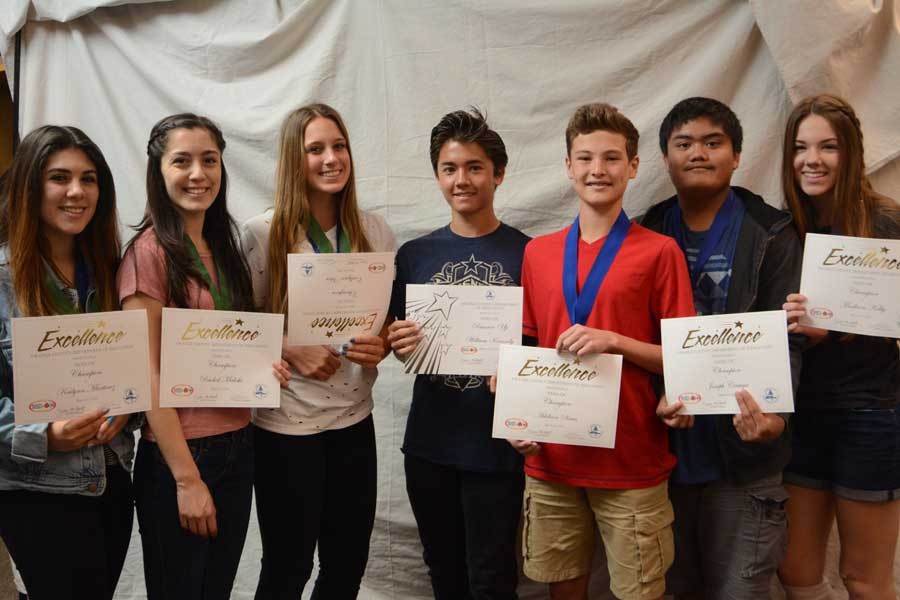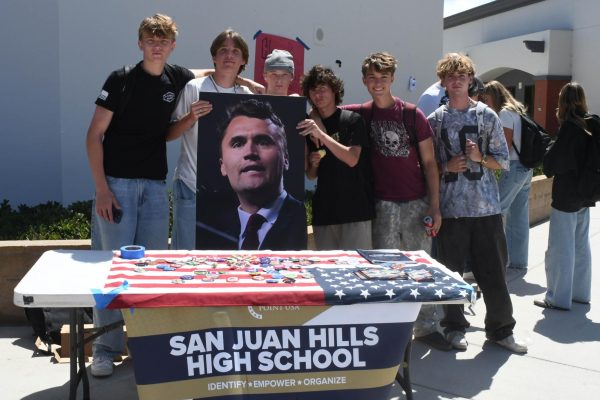Campus Groups Focus On Academics
Ten SJHHS students competed at OC History Day on Mar. 12. Two groups advanced to state level in the performance and website categories. They will present their projects in Sacramento at the California Competition.
National Ocean Science Bowl:
The Ocean Science Bowl Team competed at the NASA Jet Propulsion Lab in Pasadena for the 2016 Regional Ocean Sciences Bowl (Surf Bowl), a regional competition on Feb. 27. The theme for event was Our Changing Ocean – Science for Strong Coastal Communities.
The members are: Hayley Curtis, Tabitha Hayworth, Aishwaran Ratham, Zach Christopher, and Cameron Rizzi.
These students competed in an academic competition that focused on the biology, chemistry, physics, geology, geography, exploration and management of the world’s oceans. To prepare for the competition, the club met after school, twice a week for several months leading up to the competition.
The competition consists of toss up multiple choice buzzer rounds and short answer team challenge questions. There is a round robin session in the morning followed by a double elimination round in the afternoon.
Twenty high schools from Los Angeles and Orange County took part in the competition. San Juan Hills won two of their five round robin morning sessions and did not make it in to the double elimination rounds in the afternoon. However, one of the teams they beat was University High School of Irvine. This team went on to win the competition.
Though the students didn’t place, they represented SJHHS school very well, according to adviser, Debra Miyamoto.
National History Day Club:
Ten sophomores attended Orange County History day on Saturday March 12, seven of them advanced as finalists in the competition and two groups were selected to move on to California History Day.
William Kennedy’s individual website, Jonas Salk: Eradicating Polio, went head-to-head against projects from Irvine High School and University High School. He is a runner-up.
“I was shocked when I first heard I was chosen to be in the competition, so you can imagine my reaction when I found out I was a finalist. I really didn’t believe my ears,” Kennedy said.
Advancing as finalists and moving on to state-level competition are Joseph Casuga, Madison Kelly, and Addison Simis with their group website, The Apollo Program: Space Race to Detente. The project traced the Apollo program from its Cold War origins to the eventual cooperation with the Soviets in the Apollo-Soyuz orbital docking in 1975.
“I like working with my team and we are very happy with how our project turned out,” said Kelly.
“It provided me with a totally new experience, and I got to see and meet new people who were doing the same topic as I was,” said Simis. “I liked seeing the other competitors, too.”
Kailynn Martinez, Cadlynn Viter, and Rachel Mahshi also advanced to state competition in the group performance category. They creatively incorporated dance and dialogue into their presentation and were selected as finalists for their project entitled Martha Graham: Exploring Modern Dance.
“We each were working on the same topic separately but the idea of doing a dance brought us together and we became friends,” said Viter to the judges during the interview after the performance.
The theme of this year’s National History Day competition was “exploration, encounter and exchange in history.”
The team from SJHHS was drawn from Mr. Kaiser’s world history classes, who worked on the project in first semester. From there, former state champion in performance and History Day Club President Amanda Rooker selected likely winners.
“I started the club because I knew that Nation History Day was impactful and I wanted to give more opportunity to other students,” said Rooker.
The club applied for and received a $500 grant from the Orange County Department of Education to fund the team’s entry fees. They called the grant H.I.P.S.T.E.R, which stands for: Historical Inquiry Prepares Students, Technology Engages with Results.
“This is education, right? So you need a good acronym to get a grant,” Kaiser said.
The goal of the grant was to involve non-AP students in History Day to complete a project aligned with the NHD theme, common core, and 21st Century standards as well as sponsor as many as possible at the county competition.
While the competition has categories for papers, exhibits, and documentaries, the students from SJHHS mainly worked with websites.
“That’s because we had access to Chromebooks in the classroom,” according to Kaiser.
The exception was the performance group who applied their first semester research to create a performance on modern dance innovator Martha Graham. Kailynn and Cadlynn are involved in the dance program at SJHHS. Along with Cadlynn Viter, they then created a script and added choreography and blocking, also organizing and creating props and costumes.
“It is incredible that Mr. Kaiser’s world history students had the opportunity to participate in this competition. It requires a lot of effort, but I have seen it inspire a passion for history while also preparing students with skills they will be expected to know in college,” said Rooker.
She hopes that the students that competed in the county competition will keep the club going after she leaves next year and that other teachers at SJHHS might want to try it with their students.
Academic Decathlon:
The Academic Decathlon wrapped up its competition season in February, placing 9th in its division and 21st overall (out of 43 competing schools in Orange County). Under captain Justin Perez (12), nine San Juan Hills students competed in topics ranging from literature and economics to speech, interview, and essay.
This year’s subject, India, challenged SJHHS decathletes as they spent hours studying each week in the months leading up to the final competition. In the end, three decathletes medaled in the county competition: Gabriela Urdaneta-Carrera (12) in essay, art, and music; Newara Faltas (11) in art, interview, literature, math, and social science; and India McFadden (12) in interview.
To qualify for Academic Decathlon, interested students interview with head coach Danielle Serio late in the Spring, when semester grades are preliminary. A follow-up interview in the fall determines the final roster for the year. Students of all GPAs make the final cut, as Academic Decathlon requires competing students with GPAs of three separate ranges, from 4.0 to 2.99 or below.
For the 2016-17 competition season, SJHHS decathletes will be studying a new subject: World War II. Under the guidance of new captain Jenna Bowman (11), next year’s team is confident they’ll continue to rack up medals and maybe even take home the top prize: a trip to the state competition in Sacramento.
Model United Nations:
MUN students attended 3 conferences this year and the last will be in April. Conferences are gatherings with other schools and students involved in MUN. They follow a fixed format. Following check-in, there are opening ceremonies, committee meetings, lunch, committee resumes, and closing ceremonies.
During opening ceremonies, host schools introduce a specific program. A common trend at conferences is for the school to advocate for the fundraising for a certain organization. Capo and Laguna Hills chose to raise money for clean water access, for example.
Others included the Commission on the Status of Women (CSW), Security Council, UNICEF, and Educational, Scientific, and Cultural Organization (UNESCO). The CSW tends to focus on topics such as women in the armed forces and sexual trafficking. The Security Council most commonly deals with ISIS and the Syrian Crisis, UNICEF usually attempts to eradicate child marriages, and UNESCO often reviews the list of possible world heritage sites. Committees can have between 15 and 40 students.
Committee work consists of making your country’s stance on a certain issue known and work out possible solutions, called resolutions. The chairs, which are usually 3-4 students from the hosting school, call roll, and control the speakers’ list and moderate debate. Later delegates will find other nations that share similar views and begin to form resolution groups.
Commonly, resolutions are turned in a little after lunchtime. When committee resumes, typed resolutions are presented. After moving into voting bloc, the chair will ask delegates to favor, oppose, or abstain from voting for each resolution. A majority approval signifies a passing resolution. After this process, some conferences require that committees move into their second topic, but with only a couple hours left, this usually is not successful.
At closing ceremonies, awards are announced. Each committee has around 4 commendation awards, 2 outstanding awards, and 1 best delegate. Most conferences award the Best Delegate with a gavel. The chairs keep track of points throughout committee, and the Best Delegate is commonly that one person that is the most informed on their topic, shows great diplomacy throughout debate, and has significant public speaking skills.
The first conference we attended was at SMCH was the largest. The second was at Capo Valley in November, and the third conference at Laguna Hills H.S. in February was notable because it included two committees that aren’t in the UN: the Senate and Fortune 500.
In the Senate, delegates role-played as US senators and debated on immigration reform and gun control. Dual-delegates in the Fortune 500 committee represented companies like Pepsi and Chevron and debated topics like corporate espionage and maternity/paternity leave.
The final conference in April, hosted by Trabuco Hills, will be the most complex conference, as it has multiple dual-delegate committees and Advanced UNESCO will have countries presenting powerpoints on a potential world heritage site. They will have to convince the rest of the committee why their choice is the best and the resolution will result in the creation of a new site.
This year several students earned Best Delegate recognition at the conference including: Ketan Singh, Damian Ballard, and Henry Lutz. This is considered the highest honor with only one student per committee given this honor.
Your donation will support the student journalists of San Juan Hills High School. Your contribution will allow us to cover our annual professional memberships as well as equipment and other costs associated with bringing you high quality student journalism.






